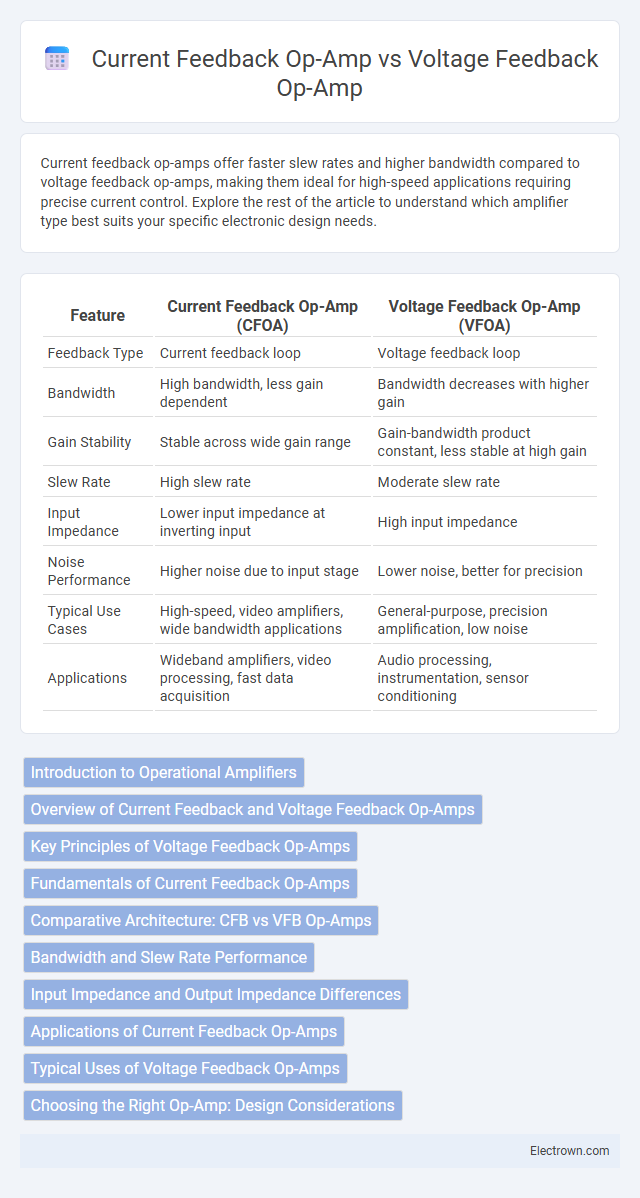Current feedback op-amps offer faster slew rates and higher bandwidth compared to voltage feedback op-amps, making them ideal for high-speed applications requiring precise current control. Explore the rest of the article to understand which amplifier type best suits your specific electronic design needs.
Table of Comparison
| Feature | Current Feedback Op-Amp (CFOA) | Voltage Feedback Op-Amp (VFOA) |
|---|---|---|
| Feedback Type | Current feedback loop | Voltage feedback loop |
| Bandwidth | High bandwidth, less gain dependent | Bandwidth decreases with higher gain |
| Gain Stability | Stable across wide gain range | Gain-bandwidth product constant, less stable at high gain |
| Slew Rate | High slew rate | Moderate slew rate |
| Input Impedance | Lower input impedance at inverting input | High input impedance |
| Noise Performance | Higher noise due to input stage | Lower noise, better for precision |
| Typical Use Cases | High-speed, video amplifiers, wide bandwidth applications | General-purpose, precision amplification, low noise |
| Applications | Wideband amplifiers, video processing, fast data acquisition | Audio processing, instrumentation, sensor conditioning |
Introduction to Operational Amplifiers
Operational amplifiers (op-amps) are fundamental building blocks in analog electronics, featuring two main types: current feedback and voltage feedback op-amps. Current feedback op-amps offer high slew rates and wide bandwidth independent of gain, making them ideal for high-speed applications. Voltage feedback op-amps provide precise gain accuracy and linearity, preferred in applications requiring stable, low distortion amplification.
Overview of Current Feedback and Voltage Feedback Op-Amps
Current feedback op-amps use a low-impedance buffer at the inverting input to achieve high slew rates and wide bandwidth, making them ideal for high-speed applications. Voltage feedback op-amps rely on voltage differences at the inputs to control the output, providing high input impedance and precise gain accuracy, suitable for general-purpose amplification. Your choice depends on whether speed or accuracy is the priority in your design.
Key Principles of Voltage Feedback Op-Amps
Voltage feedback op-amps rely on the difference in input voltage to regulate their output, using high-gain differential amplifiers to maintain a precise output voltage corresponding to the input signal. You benefit from their stable bandwidth and predictable frequency response, which makes them ideal for applications requiring accurate linear amplification. These op-amps offer high input impedance and moderate slew rates, optimizing performance in general-purpose and precision signal conditioning circuits.
Fundamentals of Current Feedback Op-Amps
Current feedback operational amplifiers (CFAs) employ a feedback mechanism where the inverting input node primarily senses current rather than voltage, allowing for high slew rates and wide bandwidth independent of gain setting. The fundamental principle relies on maintaining a virtual current summing node, which contrasts with voltage feedback op-amps that depend on a voltage difference at the inputs to control output. This architecture enables CFAs to achieve faster transient response and improved high-frequency performance, making them ideal for video and RF applications.
Comparative Architecture: CFB vs VFB Op-Amps
Current feedback (CFB) op-amps utilize a transimpedance stage with low-impedance current input nodes, enabling high slew rates and bandwidth that remain stable across gains. Voltage feedback (VFB) op-amps feature high-impedance differential voltage inputs and gain determined by the error amplifier, resulting in bandwidth that typically decreases with gain increase. The CFB architecture offers faster transient response and better bandwidth performance at higher closed-loop gains compared to the traditionally slower, gain-dependent bandwidth of VFB op-amps.
Bandwidth and Slew Rate Performance
Current feedback op-amps typically offer higher bandwidth and faster slew rates compared to voltage feedback op-amps, making them ideal for high-speed signal processing applications. The bandwidth of current feedback amplifiers remains relatively constant regardless of gain, allowing for better performance in wide frequency ranges. Your choice of op-amp should consider these advantages if you require rapid signal transitions and stable frequency response over varying gains.
Input Impedance and Output Impedance Differences
Current feedback op-amps exhibit low input impedance at the inverting terminal and relatively constant high input impedance at the non-inverting terminal, while voltage feedback op-amps maintain high input impedance on both inputs. Output impedance in current feedback op-amps is typically higher and more dependent on the feedback resistor, whereas voltage feedback op-amps generally feature low and stable output impedance. Understanding these differences ensures your amplifier selection optimizes signal integrity and bandwidth for your specific application.
Applications of Current Feedback Op-Amps
Current feedback op-amps excel in high-speed applications such as video processing, RF signal amplification, and fast data acquisition systems due to their wide bandwidth and high slew rate. Their ability to maintain stable gain over frequency makes them ideal for active filters, cable drivers, and buffer amplifiers in communication and instrumentation equipment. If you require ultra-fast transient response and flexible gain settings, current feedback op-amps provide significant advantages over traditional voltage feedback op-amps.
Typical Uses of Voltage Feedback Op-Amps
Voltage feedback op-amps are widely used in applications requiring high accuracy and low noise, such as audio amplifiers, precision integrators, and active filters. Their ability to maintain stable gain over a broad frequency range makes them ideal for instrumentation and sensor interfaces. These op-amps excel in circuits demanding high input impedance and low offset voltage, enhancing overall signal fidelity.
Choosing the Right Op-Amp: Design Considerations
Current feedback op-amps offer higher slew rates and bandwidth independent of gain, making them ideal for high-speed and video applications, while voltage feedback op-amps provide better DC accuracy and lower distortion suited for precision analog circuits. Design considerations include required bandwidth, slew rate, input bias current, and gain stability; current feedback amplifiers excel in applications demanding wide bandwidth at variable gains, whereas voltage feedback amplifiers are preferred in fixed-gain, low-noise scenarios. Selecting between them depends on the trade-offs in frequency response, noise performance, and linearity tailored to the specific application requirements.
Current feedback op-amp vs voltage feedback op-amp Infographic

 electrown.com
electrown.com